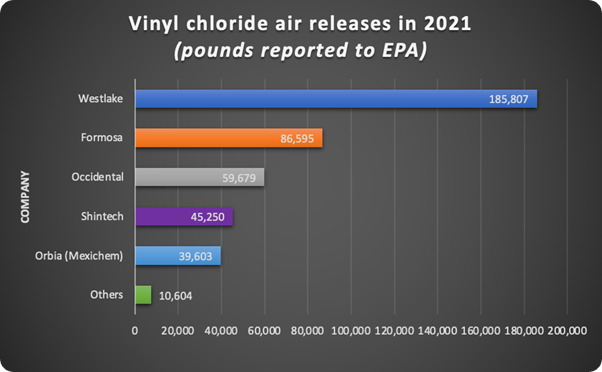Not an isolated incident
PVC Poison Plastic: An investigation following the Ohio train derailment of widespread vinyl chloride pollution caused by PVC production
The pollution resulting from the vinyl chloride train derailment is not an isolated incident
- Nineteen vinyl chloride and PVC resin factories operate in the U.S. Some of the vinyl chloride made in the U.S. supports PVC resin production in Canada, Mexico, and Colombia.
- These PVC plastics plants reported releasing more than 400,000 pounds of vinyl chloride into the air in 2021, posing risks to downwind vulnerable communities.
More than 97% of vinyl chloride released into the air in the U.S. comes from five chemical corporations that manufacture chemicals for PVC plastic building materials and consumer products: Westlake Chemical, Formosa Plastics, Occidental Chemical, Shintech, and Orbia (Mexichem). These companies, along with Ineos in Europe and several others in China, are the biggest producers of vinyl chloride globally.
According to data submitted to EPA, the number one air polluter of vinyl chloride in the United States is Westlake Chemical. The company reported releasing 185,807 pounds of vinyl chloride into the air from its chemical plants in Kentucky, Louisiana, and Mississippi in 2021. Westlake has repeatedly been fined for violating federal environmental, workplace safety, and railroad safety laws.
Occidental Chemical, which produced the vinyl chloride in three of the rail cars that derailed and were burned in East Palestine, Ohio, reported it released 59,679 pounds of vinyl chloride into the air at its chemical plants in Texas, New Jersey, and Niagara Falls (Canada) in 2021. Shintech, the producer of the PVC plastic in three other train cars that burned in the derailment, reported it released 45,250 pounds of vinyl chloride into the air at its plants in Louisiana and Texas in 2021. Both Occidental and Shintech have faced millions of dollars in fines for violating federal environmental laws, including for railroad safety violations.
Read the report
- I.Introduction
- II.Not an isolated incident
- III.Largest vinyl chloride polluters
- IV.PVC plastic and environmental justice
- V.Interactive Map
- VI.Vinyl chloride and toxic waste
- VII.Safer Solutions
- VIII.Methodology
- IX.Credits and Creative Commons License
- X.References

